Key takeaways:
- Commit mistakes often stem from haste, poor communication, and unclear requirements, impacting team dynamics and project outcomes.
- Minimizing commit mistakes enhances product quality, fosters accountability, and encourages a culture of collaboration among team members.
- Effective strategies include committing in smaller increments, writing clear commit messages, and leveraging tools like linters and automated tests.
- Reflecting on past commit mistakes routinely helps developers identify patterns and improve their practices, leading to personal and team growth.
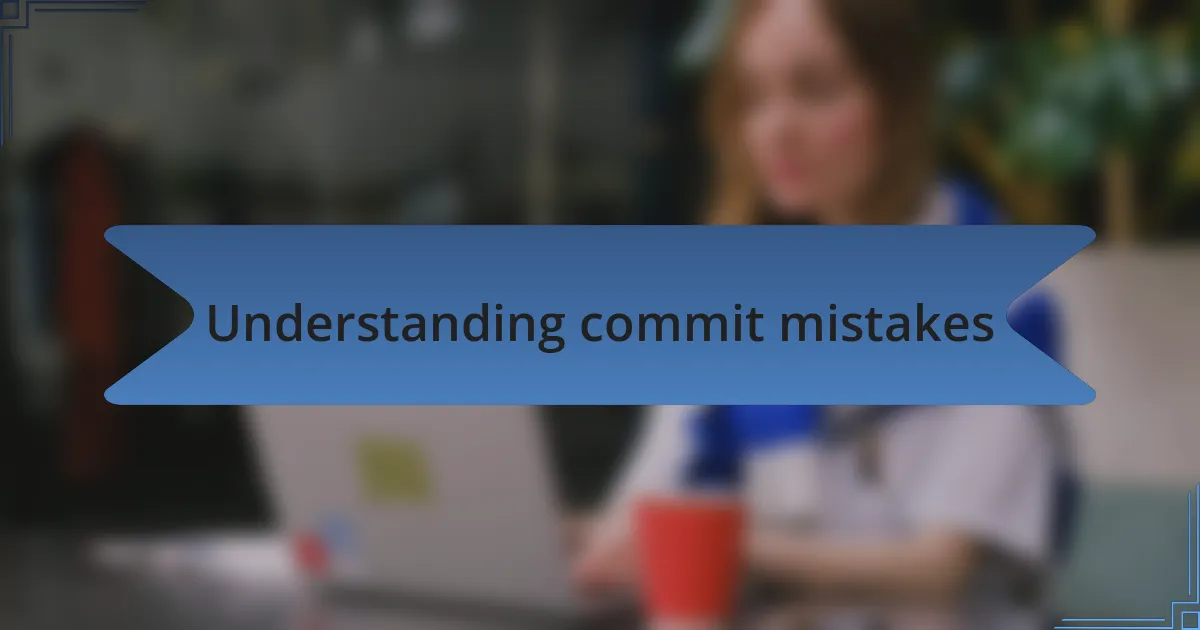
Understanding commit mistakes
Commit mistakes are often the result of oversight or haste during the coding process. I still remember a time when I pushed code with a significant bug simply because I was eager to see it go live. That moment taught me how easily excitement can overshadow thorough checks.
Understanding commit mistakes also involves acknowledging their ripple effect. When I’ve merged code that wasn’t fully tested, it didn’t just impact my work; it disrupted team members who depended on that code. Have you ever experienced a similar situation? It’s a humbling reminder of how individual actions can create wider consequences.
I’ve learned that many commit mistakes stem from poor communication or unclear project requirements. In one project, I assumed that everyone was on the same page about a feature’s functionality, only to discover later that we’d had different interpretations. This taught me the importance of clarification before hitting that commit button, fostering an environment where asking questions is encouraged.
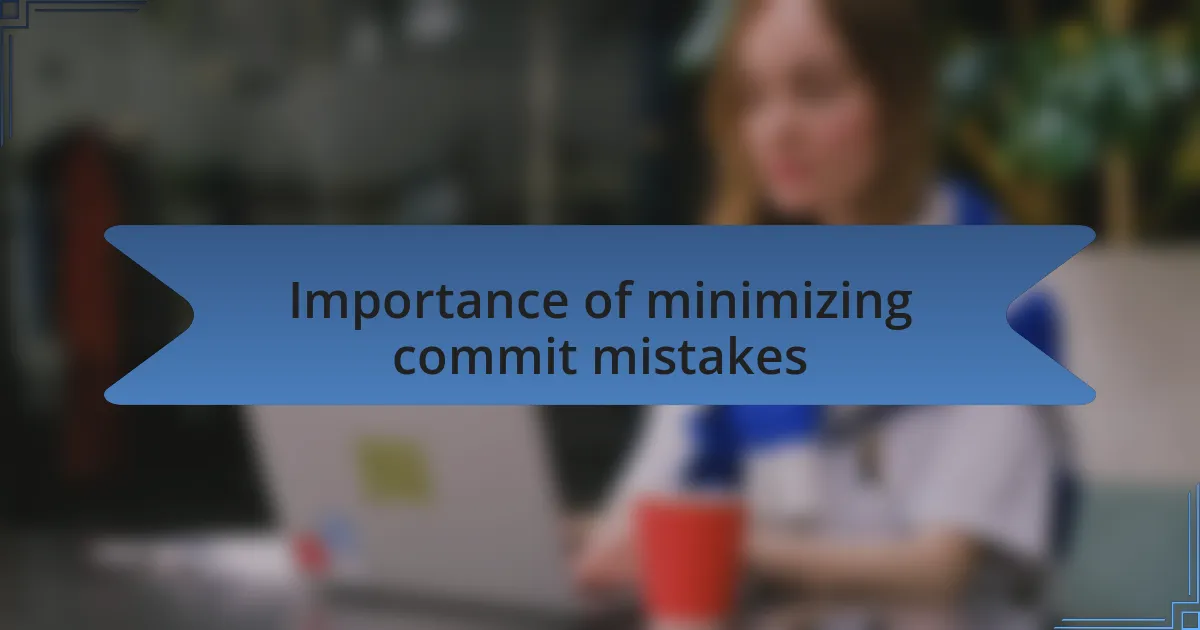
Importance of minimizing commit mistakes
Minimizing commit mistakes is crucial because it not only saves time but also enhances team dynamics. In my early days, I would often overlook minor errors, thinking they were trivial. However, I quickly realized that each mistake required time to resolve, pulling my focus away from new features and frustrating my teammates. Have you ever felt the frustration of dealing with someone else’s oversight?
Another reason to focus on reducing commit mistakes is the quality of the final product. I remember shipping a release that included an untested feature due to my overconfidence. The follow-up feedback highlighted not just the errors but also a loss of trust within my team. That experience taught me the value of diligence—ensuring that I’m not just pushing code but committing to quality and reliability.
Furthermore, minimizing commit mistakes fosters a culture of accountability. I’ve witnessed teams thrive when they emphasize best practices, encouraging each other to double-check work and share knowledge. When everyone feels responsible for their commits, it creates an atmosphere of collaboration. Have you considered how the strength of your team might improve with a shared commitment to quality?
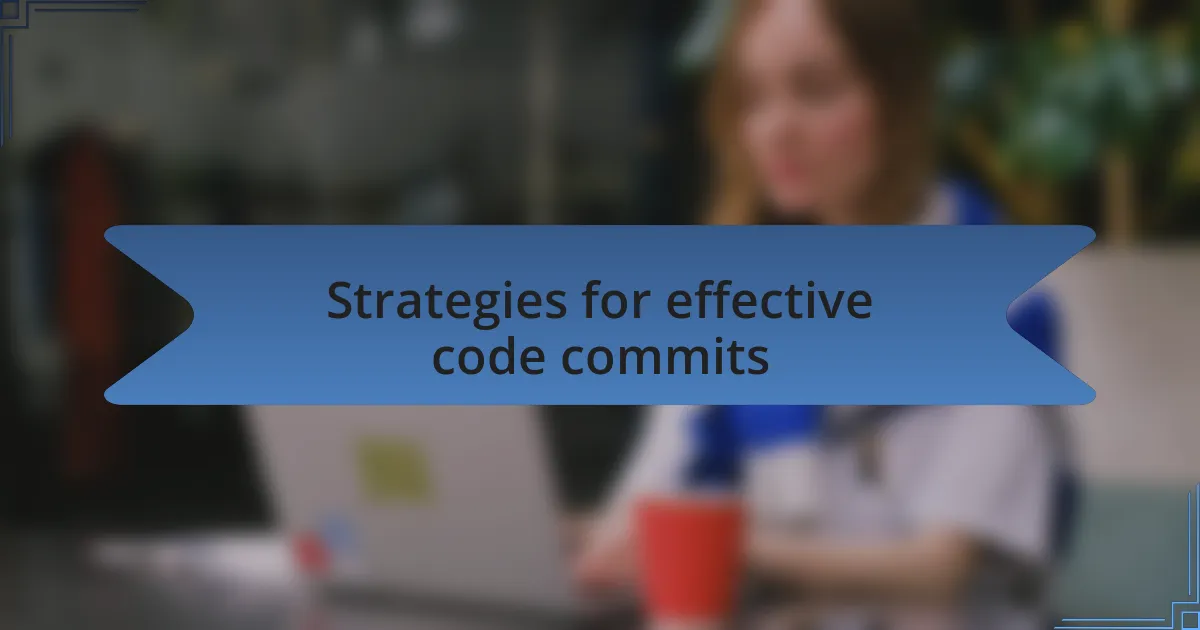
Strategies for effective code commits
One of the most effective strategies I’ve adopted is to commit in smaller increments. Early in my career, I used to push large batches of changes, thinking it would save time. However, I found that untangling mistakes in a massive commit was like trying to find a needle in a haystack. Now, I commit often, and it makes reviewing changes so much simpler. Have you tried breaking your work into bite-sized pieces?
Another strategy that has proven invaluable is writing clear and descriptive commit messages. I remember a time when a vague message left my teammates scrambling to understand the changes I made. Now, I make it a habit to include not just what I changed, but why I made the change. This practice not only aids my teammates in grasping the context but also improves my own understanding of the project as it evolves. Have you ever considered how your commit messages could bridge communication gaps within your team?
Lastly, leveraging tools like linters and automated tests has enhanced the reliability of my code commits significantly. There was a moment when I overlooked a critical syntax error, and it led to a lengthy debugging session. Today, I ensure that my code passes all required tests before hitting that commit button. This proactive approach has saved me and my team countless hours. How often do you invest time in toolset optimization to bolster your commit practices?
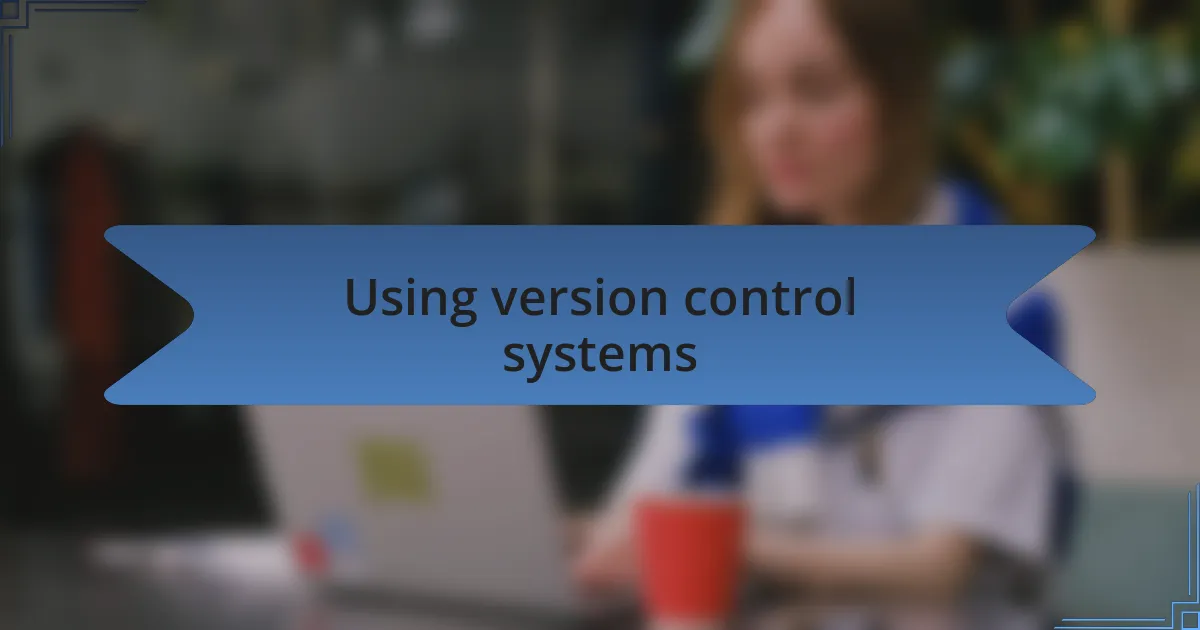
Using version control systems
Using version control systems has dramatically transformed how I manage my code. I remember the first time I replaced manual backups with Git; it felt like stepping into a new dimension of efficiency. No longer did I fear losing my work or overwriting important changes. Instead, the ability to track my modifications and revert to previous versions became a comforting safety net. Have you ever considered how much smoother your workflow could be with version control?
By branching out with version control, I’ve learned to isolate features or bug fixes, which minimizes mistakes in the main codebase. I vividly recall an instance when I created a feature branch for a critical update. While testing new functionalities, I encountered issues, but since the main branch remained untouched, I could experiment freely. This approach not only protected the integrity of my project but also instilled a sense of confidence in my coding abilities. Have you tried embracing branching in your workflow?
Moreover, collaborating with teammates became a joy rather than a challenge thanks to version control systems. One memorable project involved multiple developers working simultaneously, and Git allowed us to merge our changes without chaos. When conflicts did arise, they were straightforward to resolve because we could see exactly what had changed. I often marvel at how such tools foster teamwork; are you leveraging these systems to enhance collaboration in your projects?

Best practices for commit messages
Best practices for commit messages start with clarity. I always remind myself that a good commit message should explain the “what” and “why” of the changes. Early in my career, I made the mistake of writing vague messages like “fixed stuff.” After a while, I realized that such ambiguity created confusion for anyone reviewing the code later, including my future self. Have you ever glanced at a commit history and wondered what the heck you were thinking?
Another essential practice is to keep commit messages concise but descriptive. I aim for a 50-character summary in the subject line, followed by a more detailed explanation if necessary. When I first adopted this practice, it helped me focus on the key elements of my changes. I remember an instance where I described a critical bug fix in one line and followed up with the reasoning behind it in the body. It made understanding the context significantly easier for my teammates during code reviews. Isn’t it satisfying to see your contributions clearly explained and appreciated?
Additionally, using the imperative mood can make a notable difference. Instead of writing “added feature,” I would write “add feature.” This shift emphasizes the action and aligns with how Git records changes. I distinctly recall a project where adhering to this format improved our team’s efficiency during reviews. It cultivated a culture of professionalism that boosted our morale. Have you ever noticed how small changes in language can lead to a more cohesive team dynamic?
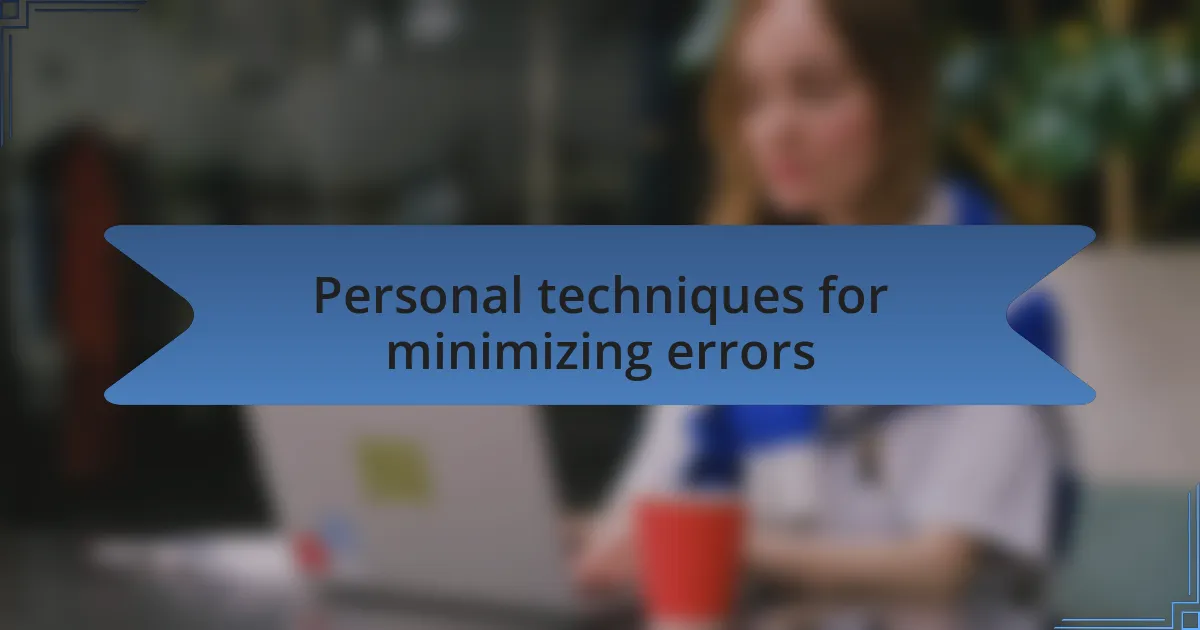
Personal techniques for minimizing errors
One technique I find invaluable for minimizing errors is conducting code reviews with a critical eye. When I’m reviewing someone else’s code, I make a conscious effort to ask probing questions about their decisions. For example, I asked a peer why they chose a specific algorithm. Their explanation not only deepened my understanding but also revealed potential improvements. Have you ever had a moment where a simple question opened up a new avenue of thought?
I also make it a point to write unit tests before I even start coding. This approach allows me to define the expected behavior of my code upfront. I remember working on a complex feature where writing tests first helped me clarify my understanding of the requirements. I found that when I sat down to code afterward, I felt more confident and less prone to making mistakes. Have you ever tried test-driven development, and how did it shift your coding mindset?
Another practice I embrace is maintaining a digital “lessons learned” repository. Whenever I encounter a tricky bug or make a mistake, I document it along with the resolution. This habit didn’t just help me avoid repeating errors; it became my go-to resource for reflection. The times I revisited that document, I often felt a sense of pride knowing I had turned past troubles into stepping stones for growth. Have you captured your learning moments in a way that fuels your future success?
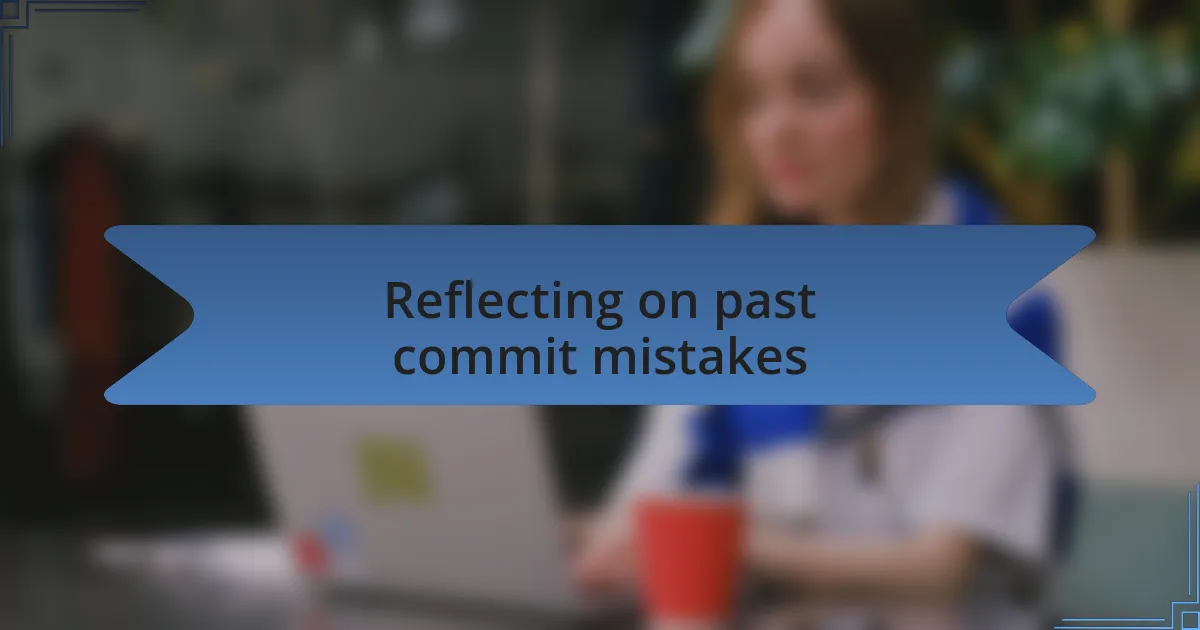
Reflecting on past commit mistakes
Reflecting on past commit mistakes has been a vital part of my growth as a developer. There was a time when I pushed a new feature without sufficiently testing its integration, which broke the build for my team. I still remember the sinking feeling in my stomach as I raced to fix the issue while my teammates waited. This experience drilled into me the importance of thoughtful commits and thorough testing.
I often revisit my Git history to analyze what went wrong and why. After one particularly chaotic commit spree, I saw patterns in my mistakes, like inconsistency in commit messages or rushing through complex changes. That realization prompted me to develop a routine where I evaluate my commits periodically, helping me become more aware of my habits. Have you ever taken the time to sift through your own commit history and uncovered valuable lessons?
The emotional weight of a significant commit blunder lingers, but it drives me to be better. I once accidentally merged a branch with a lot of unfinished work, which led to a frustrating week for my entire team. It was disheartening, but looking back, I find that the frustration pushed me to establish clearer commit protocols. What lessons have your mistakes taught you that shaped your future decisions?